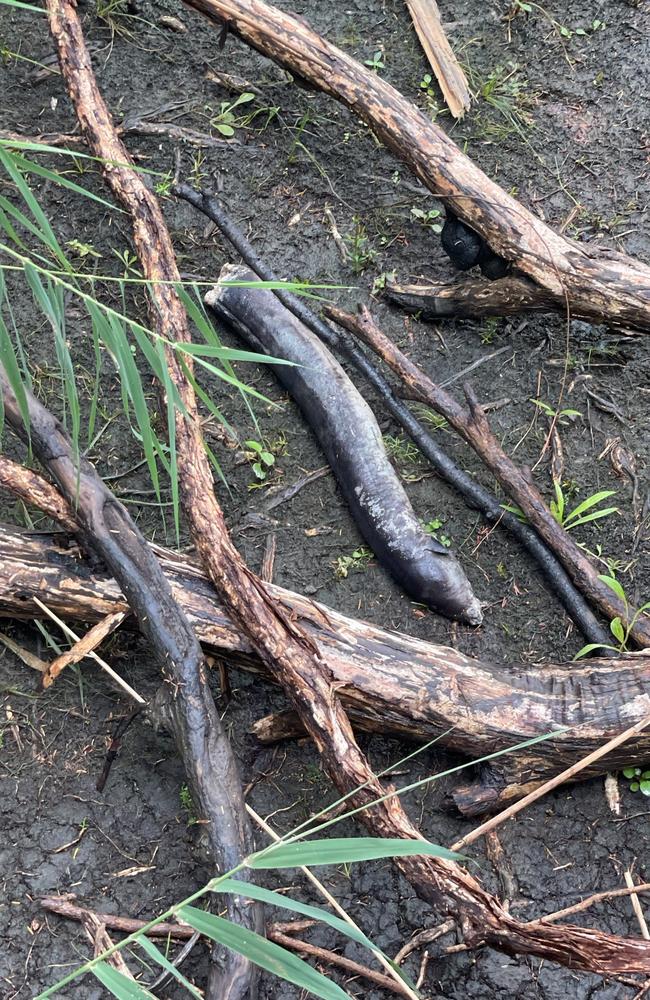Trevallyn Dam: Four mass eel deaths since $1m bypass built
A dam in the state’s north has become the subject of a pitched battle between a third-generation eel farmer and Hydro Tasmania amid a backdrop of continuing eel deaths. DETAILS >

Tasmania
Don't miss out on the headlines from Tasmania. Followed categories will be added to My News.
The latest mass death of native short-finned eels at the foot of a Hydro Tasmania dam is the fourth since the installation of a feted eel bypass, a chute in the dam wall aiming to help eels traverse downstream during spawning season.
On March 21, dozens of dead eels had washed up on the banks of the Tamar at Launceston’s Royal Park. Pictures provided to the Mercury from the event illustrated several eels missing portions of their bodies.

Authorities have blamed Lake Trevallyn’s hydro-electric dam and its turbines, which eels sometimes pass through during spawning season.
In 2020, Hydro Tasmania installed a $1m eel bypass – a chute – on the dam’s western side, to allow eels to travel downstream safely. The project went on to win that year’s Regional Infrastructure Project Award at the Australian Water Association’s Tasmanian Water Awards.
An eel ‘ladder’ for the upstream journey has existed since the 1990s.

However, since the bypass’ installation, there have still been four mass kill events reported to the Environment Protection Authority, according to figures provided to the Mercury.
Mass deaths occurred in February 2021, February and March last year, and last month, as well as April 2018 and November 2019, before the bypass’ installation.

“Four of those occasions were attributed to seasonal migration and interaction with the power station,” an authority spokeswoman said.
“One report was of five eels caught in a stagnant pool of water.
“On all occasions it was unlikely that the quantity of eel mortalities caused any significant environmental impacts.

“However localised, temporary odour may have been experienced in some parts of the Tamar River estuary as the eels decomposed.”
The authority confirmed that last month’s event was also because of eels passing through the dam turbines.
Hydro Tasmania would not provide any figures on how many eels it estimated passed through the turbines per year but concede that “some” still did.
“Sonar monitoring indicates that thousands of eels use this bypass to safely traverse the dam every autumn allowing them to breed and supporting a sustainable population,” a spokeswoman said.
“Unfortunately, some eel deaths do still occur.
“We take this issue seriously and continue to work with local and international researchers to monitor and improve our approaches.”

The spokeswoman said the issue of native species passing through hydro-electric turbines was not one unique to Trevallyn Power Station or even Tasmania.
“Native short-finned eels embark on an annual downstream migration in Tasmanian rivers to spawn at sea,” the spokeswoman said.
“The construction of the Trevallyn Dam in 1955 blocked this passage in the South Esk River. “Since this time, many eels have passed through the power station, causing death. This is an issue faced by hydropower operators worldwide.”
NATIVE EEL INDUSTRY ON ITS KNEES: EXPORTER’S PLEA
The third-generation boss of Tasmania’s last significant harvesters of short-finned native eels says a Hydro Tasmania’s decision in 2020 to prevent his company from netting eels within 500m of Lake Trevallyn’s dam has been ruinous for his business.
Brad Finlayson, owner of 50-year industry veteran Tasmanian Eel Exporters, said about 50 per cent of his annual harvest came from above Trevallyn Dam.
However, after the installation of Hydro Tasmania’s $1m eel bypass, Mr Finlayson was banned from fishing with 500m of the dam wall.
He said his company used to employ up to 12 workers and export as much as 40 tonnes of eel, but now they are just three – Mr Finlayson, his son and his brother. He said they now only export 12-15 tonnes per annum.
“It’s hurt our relationship with South Korean importers. Lake Trevallyn eels are prime targets. (The exclusion) has cost us nearly $1m over three years in lost revenue,” Mr Finlayson.
He said that there were far fewer mass eel deaths before the installation of the bypass because his company was catching “80-90 per cent” of the eels passing through.
Asked why it was so critical his company fish adjacent to the dam wall, he said it was because of a feature known as a “riparian valve”.

“They’re attracted to that corner of the dam wall because of the flow of water. The eel are very inquisitive, they’ll come back up on to the surface, that’s why we’ve done well,” Mr Finlayson.
He called on Hydro Tasmania to reverse the imposition of an exclusion zone and accused Inland Fisheries Service (IFS) of allowing his industry to wither on the vine.
“Dam safety exclusion zones are in place around all Hydro Tasmania dams and power stations to minimise safety risks,” a spokeswoman said.
“Exclusion zones are covered by Marine and Safety Tasmania legislation.
“There is an exclusion zone of 500m upstream of the Trevallyn Dam wall.
“This area represents a very small proportion of the larger area included in the license held by Tasmanian Eel Exporters.
“Hydro Tasmania is supportive of commercial eel fishing in approved, licenced areas.”
An IFS spokeswoman said Tasmania’s eel harvest reduced from 53.32 tonnes in 2016–17 to 31.16 tonnes in 2021–22.
“IFS understands that most of the held catch is exported with an estimated gross export value of $17 per kilogram,” she said.
The spokeswoman noted that IFS provided Mr Finlayson’s company with a free annual 50kg allocations of juvenile (glass) eels to restock waters when required.





